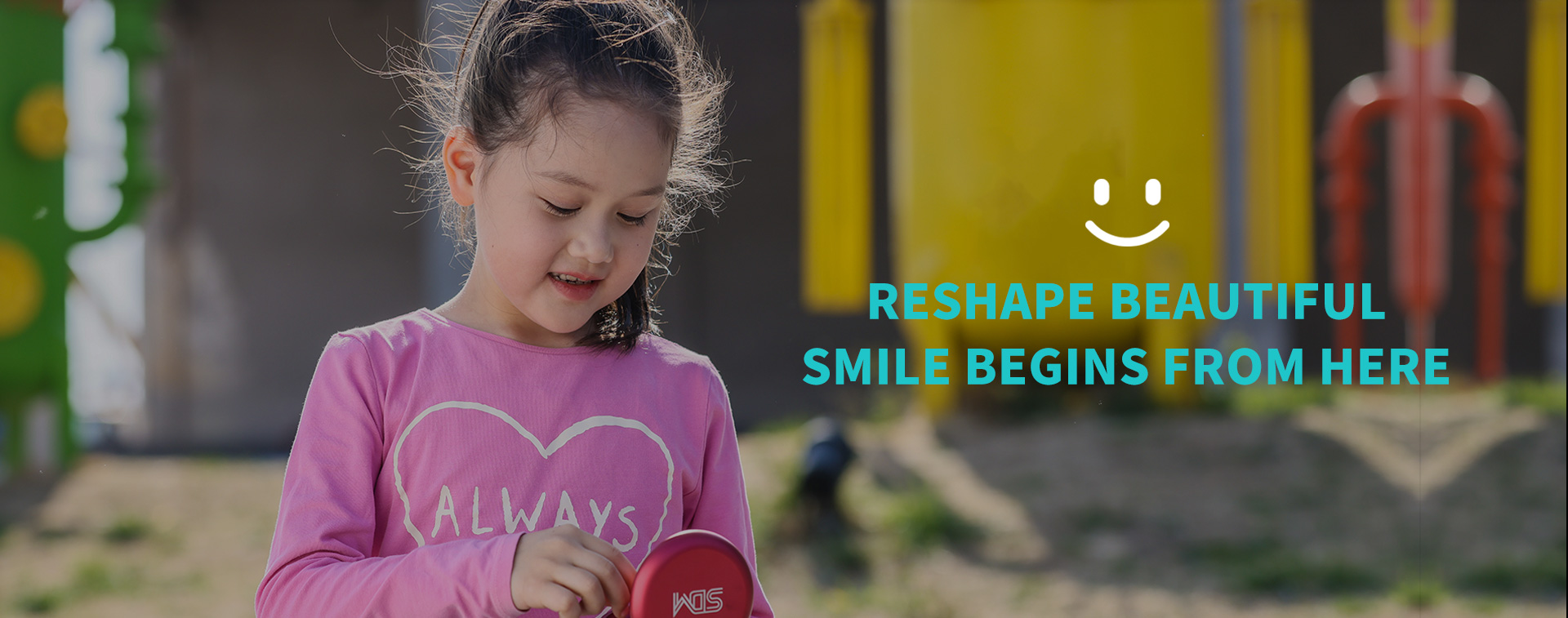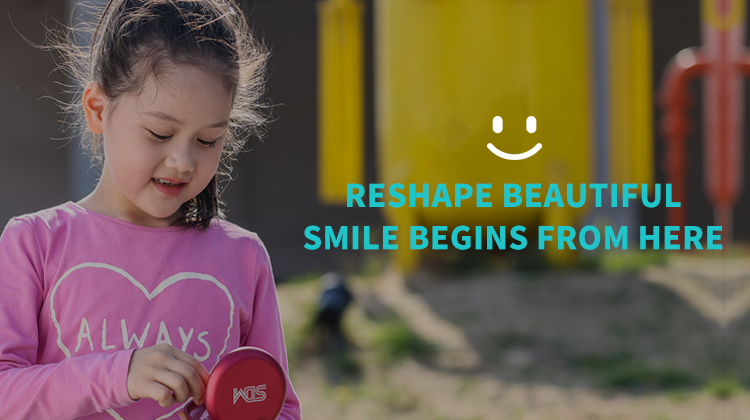SDM Small Classroom | Essentials of Oral and Facial Photo Shooting for Children's Orthodontics
Date:2021-09-24 Views:223
For invisible correction:
Clear and clean intraoral and facial photos can not only help us accurately record the patient's preoperative condition, improve the treatment plan, but also communicate and discuss as a before-and-after comparison after surgery.
However, with the advent of a variety of photographic equipment and courses on the market, more doctors want to learn to take professional medical photography, but they are unable to start. In addition, there are different needs for different shooting scenes, especially the particularity of pediatric patients, which requires us to remove qualified works in a short period of time, which increases the difficulty. Only with skilled technology and sharp-handed equipment can we achieve the goal.
This article aims to help you quickly establish the professional technology of children's oral photography, and use simple classification and methods to teach you how to choose equipment and take photos according to the actual situation.
Equipment selection and parameter adjustment in orthodontic shooting
intraoral photo

For taking intraoral photos, the equipment we need to prepare in advance are:
1) SLR camera:Canon and Nikon equipment is optional, cheap machines are easy to operate, light in weight, and there is no need to buy expensive equipment with a body of tens of thousands of yuan. (Note to ask the customer service two questions: 1. It is required to be a half-frame camera; 2. It is required to have an external flash of the auxiliary factory)
2) Macro lens:Please pay attention to the lens mount model when buying a macro lens, Canon and Nikon lenses are not compatible. It is recommended to buy a 60mm F2.8 lens (both brands have this model). This model of lens weight price and image quality can achieve very good results.
3) Flash:If you only take orthodontic intraoral photography, you can purchase the Shenniu ML-150 ring flash to meet the requirements. Inexpensive and easy to operate, just adjust the flash intensity.
4) Corner hook:Adults prepare 1 set of adult retractors, 1 oral angle retractor, and 1 set of finger retractors for taking photos of the upper and lower jaws; children prepare 1 set of children's retractors, 1 oral angle retractor, and 1 set of finger retractors for upper and lower jaw photography.
5)Reflector:Adults choose a wide version of the reflector, which can better capture the entire dentition. Children try to choose a narrow version of the reflector for children, or a double-headed reflector (narrow on one side, wide on one side, wide for adults, narrow for children). May reduce patient discomfort.
Parameter adjustment of intraoral photo:
1)Since the intraoral photo is a macro lens, the aperture should be reduced as much as possible under the fill light of the flash to achieve the effect of deep depth of field with clear dentition.
2)The shutter speed takes into account the fast flash time of the flash and the stability of the shooting. It is recommended that you set the shutter to 1/125s;
3)ISO adjustment is related to the brightness of the photo, usually adjusted to ISO200;
4)The white balance is related to the color of the photo, and it is adjusted to the flash mode where the icon is lightning;
5)After the flash is installed, it is usually adjusted to 1/4 power level, which can ensure the fast recycling of the flash, and prevent the photos from being too dark;

During the shooting process, first ask the patient to prepare a photo of anterior occlusal occlusion to check the exposure brightness, and then quickly adjust the parameters. Generally, if the photos are too bright, we can reduce the ISO (for example, if the photos are too bright, we can adjust the ISO from 200 to 100); on the contrary, if the photo is too dark, we can also increase the ISO (for example, if the photo is adjusted from ISO200 to ISO400, the photo taken will become brighter).
face to face

The items we need to prepare for the photo shoot are:
1) SLR camera:You can shoot the same model in the same mouth of the fuselage;
2) Lens:You can choose a 60mm macro lens or a 50mm portrait lens or a zoom lens. Some clinics buy a half-frame body with a 100mm lens (100mm Canon, 105mm Nikon). The overall shooting distance will be too far, and the equipment will be heavy. It's too big for beginners to shoot, so it is recommended that you buy a half-frame camera body with a 60mm lens and you can shoot inside the mouth;
3) Background cloth:White and black are available;
4) Photography light:Two studio flashes with a softbox are enough;
Parameter adjustment of face photography:
1)The face photo is a studio shot, and the aperture value is generally adjusted to between F8-F16;
2)The shutter speed takes into account the fast flash time of the flash and the stability of the shooting. It is recommended that you set the shutter to 1/125s;
3)ISO adjustment is related to the brightness of the photo, usually adjusted to ISO200;
4)The white balance is related to the color of the photo, and it is adjusted to the flash mode where the icon is lightning;
5)After the flash is installed, it is usually adjusted to 1/4 power level, which can ensure the fast recycling of the flash, and prevent the photos from being too dark;

During the shooting process, ask the patient to sit down and take a photo to check the exposure brightness. Generally, if the photo is too bright, we can reduce the aperture, that is, increase the aperture value (for example, if the photo is too bright, we can adjust the aperture from F8 to F11). ); on the contrary, if the photo is too dark, we can also increase the aperture, that is, the aperture value is smaller (for example, the photo taken by adjusting F16 to F11 will become brighter).
Precautions for taking pictures of children

When taking pictures of children's information, due to the different levels of attention and cooperation of children, the whole process is often unsmooth, delaying time at light, and unable to carry out follow-up operations at worst. Parents lose patience, so give correct guidance to children. It is especially important to use the right tools:
1.When taking intraoral photos, be sure to choose a child's hook to pull the corner of the mouth. Before pulling, the edge of the hook must be moistened to prevent the child's corner of the mouth from being rubbed, and the corner of the mouth should be moistened with Vaseline for double protection;
2.When taking side occlusal photos, the child may not grit his teeth. At this time, let the child swallow saliva and grit his teeth, and shoot sideways, the success rate will be higher;
3.When shooting on the upper and lower jaws, choose a small reflector to place it, and master the blowing intensity when blowing to prevent the pharyngeal reaction stimulation caused by sudden blowing;
4.You must be proficient in camera parameters. Children have limited patience. Taking oral data in a short period of time has a high success rate. Even exposure can be adjusted on the computer later. As long as the composition is correct, shoot directly. It is more important than getting good information;
5.You must know how to capture the face photo. Place a swivel chair on the chair. You can place toys or eye-catching posters at a special angle (45-degree direction, 90-degree direction) to improve the child's attention and then capture it. The effect will be better. Try not to use a tripod to fix the machine When the child is naughty, the head will not be fixed in a certain direction, and it is very important to capture quickly;
6.Face photos can be taken quickly and multiple times. The more you take in the early stage, the more likely you are to choose a suitable picture in the later stage.
For invisible correction:
Clear and clean intraoral and facial photos can not only help us accurately record the patient's preoperative condition, improve the treatment plan, but also communicate and discuss as a before-and-after comparison after surgery.
However, with the advent of a variety of photographic equipment and courses on the market, more doctors want to learn to take professional medical photography, but they are unable to start. In addition, there are different needs for different shooting scenes, especially the particularity of pediatric patients, which requires us to remove qualified works in a short period of time, which increases the difficulty. Only with skilled technology and sharp-handed equipment can we achieve the goal.
This article aims to help you quickly establish the professional technology of children's oral photography, and use simple classification and methods to teach you how to choose equipment and take photos according to the actual situation.
Equipment selection and parameter adjustment in orthodontic shooting
intraoral photo

For taking intraoral photos, the equipment we need to prepare in advance are:
1) SLR camera:Canon and Nikon equipment is optional, cheap machines are easy to operate, light in weight, and there is no need to buy expensive equipment with a body of tens of thousands of yuan. (Note to ask the customer service two questions: 1. It is required to be a half-frame camera; 2. It is required to have an external flash of the auxiliary factory)
2) Macro lens:Please pay attention to the lens mount model when buying a macro lens, Canon and Nikon lenses are not compatible. It is recommended to buy a 60mm F2.8 lens (both brands have this model). This model of lens weight price and image quality can achieve very good results.
3) Flash:If you only take orthodontic intraoral photography, you can purchase the Shenniu ML-150 ring flash to meet the requirements. Inexpensive and easy to operate, just adjust the flash intensity.
4) Corner hook:Adults prepare 1 set of adult retractors, 1 oral angle retractor, and 1 set of finger retractors for taking photos of the upper and lower jaws; children prepare 1 set of children's retractors, 1 oral angle retractor, and 1 set of finger retractors for upper and lower jaw photography.
5)Reflector:Adults choose a wide version of the reflector, which can better capture the entire dentition. Children try to choose a narrow version of the reflector for children, or a double-headed reflector (narrow on one side, wide on one side, wide for adults, narrow for children). May reduce patient discomfort.
Parameter adjustment of intraoral photo:
1)Since the intraoral photo is a macro lens, the aperture should be reduced as much as possible under the fill light of the flash to achieve the effect of deep depth of field with clear dentition.
2)The shutter speed takes into account the fast flash time of the flash and the stability of the shooting. It is recommended that you set the shutter to 1/125s;
3)ISO adjustment is related to the brightness of the photo, usually adjusted to ISO200;
4)The white balance is related to the color of the photo, and it is adjusted to the flash mode where the icon is lightning;
5)After the flash is installed, it is usually adjusted to 1/4 power level, which can ensure the fast recycling of the flash, and prevent the photos from being too dark;

During the shooting process, first ask the patient to prepare a photo of anterior occlusal occlusion to check the exposure brightness, and then quickly adjust the parameters. Generally, if the photos are too bright, we can reduce the ISO (for example, if the photos are too bright, we can adjust the ISO from 200 to 100); on the contrary, if the photo is too dark, we can also increase the ISO (for example, if the photo is adjusted from ISO200 to ISO400, the photo taken will become brighter).
face to face

The items we need to prepare for the photo shoot are:
1) SLR camera:You can shoot the same model in the same mouth of the fuselage;
2) Lens:You can choose a 60mm macro lens or a 50mm portrait lens or a zoom lens. Some clinics buy a half-frame body with a 100mm lens (100mm Canon, 105mm Nikon). The overall shooting distance will be too far, and the equipment will be heavy. It's too big for beginners to shoot, so it is recommended that you buy a half-frame camera body with a 60mm lens and you can shoot inside the mouth;
3) Background cloth:White and black are available;
4) Photography light:Two studio flashes with a softbox are enough;
Parameter adjustment of face photography:
1)The face photo is a studio shot, and the aperture value is generally adjusted to between F8-F16;
2)The shutter speed takes into account the fast flash time of the flash and the stability of the shooting. It is recommended that you set the shutter to 1/125s;
3)ISO adjustment is related to the brightness of the photo, usually adjusted to ISO200;
4)The white balance is related to the color of the photo, and it is adjusted to the flash mode where the icon is lightning;
5)After the flash is installed, it is usually adjusted to 1/4 power level, which can ensure the fast recycling of the flash, and prevent the photos from being too dark;

During the shooting process, ask the patient to sit down and take a photo to check the exposure brightness. Generally, if the photo is too bright, we can reduce the aperture, that is, increase the aperture value (for example, if the photo is too bright, we can adjust the aperture from F8 to F11). ); on the contrary, if the photo is too dark, we can also increase the aperture, that is, the aperture value is smaller (for example, the photo taken by adjusting F16 to F11 will become brighter).
Precautions for taking pictures of children

When taking pictures of children's information, due to the different levels of attention and cooperation of children, the whole process is often unsmooth, delaying time at light, and unable to carry out follow-up operations at worst. Parents lose patience, so give correct guidance to children. It is especially important to use the right tools:
1.When taking intraoral photos, be sure to choose a child's hook to pull the corner of the mouth. Before pulling, the edge of the hook must be moistened to prevent the child's corner of the mouth from being rubbed, and the corner of the mouth should be moistened with Vaseline for double protection;
2.When taking side occlusal photos, the child may not grit his teeth. At this time, let the child swallow saliva and grit his teeth, and shoot sideways, the success rate will be higher;
3.When shooting on the upper and lower jaws, choose a small reflector to place it, and master the blowing intensity when blowing to prevent the pharyngeal reaction stimulation caused by sudden blowing;
4.You must be proficient in camera parameters. Children have limited patience. Taking oral data in a short period of time has a high success rate. Even exposure can be adjusted on the computer later. As long as the composition is correct, shoot directly. It is more important than getting good information;
5.You must know how to capture the face photo. Place a swivel chair on the chair. You can place toys or eye-catching posters at a special angle (45-degree direction, 90-degree direction) to improve the child's attention and then capture it. The effect will be better. Try not to use a tripod to fix the machine When the child is naughty, the head will not be fixed in a certain direction, and it is very important to capture quickly;
6.Face photos can be taken quickly and multiple times. The more you take in the early stage, the more likely you are to choose a suitable picture in the later stage.



